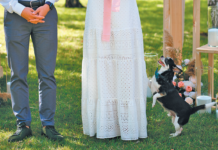Dog likes a certain “type”
Q I really enjoyed your article in the September issue entitled “My Dog Hates Other Dogs.” That describes Milo. I adopted him three years ago when his owner surrendered him. He lived with four other dogs and a parrot and had to be given up because he had become aggressive toward the bird. He is also reactive when he sees other dogs, and I have to work to keep a good distance. Except for Oscar. Milo goes crazy and has to greet Oscar, a schnauzer, every time we go to class. In your article you talked about dogs who had a bad experience with a specific breed of dog as a puppy often being afraid of that breed later on. Conversely, I wonder whether a dog who has had a positive experience with a dog of a specific breed can automatically become happy and excited when they see that breed. I wonder if Milo was friends with a schnauzer in his pervious home. He does not react this way with any other dog.
Bobbie Roeske
Lombard, Illinois

Dear Ms. Roeske,
A Dogs “definitely form positive prejudices as well as negative ones,” says Tufts Animal Behavior Clinic veterinarian Stephanie Borns-Weil, DVM. “They make positive associations based on their experience. In this particular case, we don’t know if the good feelings would translate to other schnauzers, as you haven’t said how Milo reacts to other dogs of that breed. But it may not even be Oscar’s breed that’s attracting Milo. It can be something about his odor, or his behavior, that you’re not picking up on. Maybe there’s some kind of social signal between the two dogs that Milo recognizes, that in some way reminds him of another dog he was once friends with.
“It could even be some kind of association between Oscar and something that happens when Oscar is around. For instance, if Milo happens to get treats every time he’s near Oscar, he might start to feel, ‘Wow, when this dog is around, I’m awfully happy.’ That is, Milo could be learning to prefer Oscar.” But sometimes it very much is a positive experience with a dog of a particular breed in the distant past that creates the bond.
“I once had a dog, a Chihuahua, who always ran over to toddlers,” Dr. Borns-Weil relates. “He liked all people, but he particularly liked boys. He came to us that way, so we assumed he had lived with a little boy before us. We knew based on his feelings that we had to give him a little boy of his own — which we did.”
Dog keeps swallowing fruit pits
Q Our 5-year-old beagle, Castle, just had his second surgery in three months to remove a stone fruit pit that he swallowed and which subsequently became lodged in his small intestine. After the first surgery, we got a basket muzzle to protect him on walks till fruit season was over. Well, fruit season is over, but somehow he got another pit, even though there are no fruit trees in our back yard and we didn’t see him get one on a walk. We suspect a squirrel left it behind the house.

My question is this: is there another way to protect him other than with a basket muzzle? He is willing to walk much less with it on — we usually go three to five miles a day, and with the muzzle he’ll only go around two. Also, he rubs his nose a lot once it’s off, which makes us think he finds it uncomfortable. Part of the problem we had with the Baskerville muzzle, which you’ve recommended in a previous issue, is that Castle is between a small and a medium. The medium hits his eyes so he squints (or it falls off), and the small it a little too small.
Any advice would be greatly appreciated.
Beth Karpas
Los Altos, California
Dear Ms. Karpas,
A We can understand your concern. An obstruction anywhere in the gastrointestinal tract is serious, and surgery to correct the problem is not cheap. Furthermore, your issue is a tough one. There’s a limit to what you can do.
That said, take heart. The growing season for stone fruits in your area ranges only from about late spring till August. This is not a problem you should have to worry about to the same degree all year.
We recommend, to start with, extra vigilance. When you’re walking with Castle, keep scanning the ground two to three yards ahead of where you are. It makes for a less carefree stroll, but at least that way, your dog’s mouth has less of chance of being faster than your eyes.
It would also be a good idea to use a head halter such as a Gentle Leader rather than simply a collar around his neck with a regular leash. A head halter will allow you to gently but firmly (and quickly) tug Castle’s head away from any pits he finds. Pair the use of the head halter with praise and treats to help him get used to it before you take him on walks with it.
If a head halter is out of the question and you want to stick with the muzzle, make sure you put the collar through the bottom loop. The collar loop serves to keep the muzzle out of a dog’s eyes. And if the chin strap simply cannot be made tight enough, double it over or cut it and then sew it together. You could also try a different brand of muzzle. Depending on the shape of a dog’s nose and other factors, some simply fit — and work — better than others. You may even be able to have one custom-made.
When it comes to the backyard, be as super-vigilant as possible and always walk around the area to make sure there are no fruits or pits to pick up. The odds are low that a squirrel or other animal is going to come every day and leave a pit, but your daily close watch will help minimize that chance even further. If you feel there’s just too much risk in that, your only option is to let him out in the yard with a muzzle on.
Finally, are there places in your area where fruit trees don’t grow, perhaps near the water? That will allow you to walk Castle without having to be on high alert all the time.
Is one bad food worse than another?
Q Dog owners hear all the time that chocolate, onions, garlic, grapes, and raisins can make their pet very sick. Is one as bad as the other, or should I be just as vigilant about every single one of these foods?
Cody Benjamin
Abilene, Texas
Dear Mr. Benjamin,
A We believe that to avoid any kind of poisoning resulting from ingestion of the foods you mention, it is a good idea simply not to let any of those items ever pass your dog’s lips. Dogs come in all sizes and with all degrees of variability in how sensitive their gastrointestinal systems are, how quickly they can clear toxins from their bloodstream once they ingest harmful food, and a number of other factors. Thus, it’s just good, clean business never to let your dog have any of those things on purpose and certainly not to leave any of them out on a counter or table where your pet could get hold of them.
But the truth of the matter is that some of the “forbidden” foods tend to be more harmful in smaller amounts than others. We are talking specifically here about grapes and raisins. Even a few may be associated with kidney failure, which is often terminal.
As far as onions and garlic, it would take more than a tiny amount to make your dog sick. But if onions or garlic did make your dog ill, you’d have a very dire situation on your hands. Both of those foods can cause hemolytic anemia, a disease in which red blood cells are destroyed. Without red blood cells, which contain the hemoglobin that carries oxygen, your dog won’t be able to breathe in a way that lets enough oxygen get to all the cells of her body. The result could be lethargy, or worse.
When it comes to chocolate, the problem is that it contains a caffeine-like compound called theobromine that in a dog can cause signs similar to those of a major caffeine overdose — agitation, hyper-excitation, and even seizures if the dose is high enough. A single chocolate chip cookie left out on a plate is not going to be a problem for a larger, adult dog who scarfs it down while you’re not looking. But a young puppy or toy breed can get sick from less than a candy bar’s worth of chocolate, with dark chocolate being a greater offender than milk chocolate.
But like we said, why play Russian roulette with any of these foods? “Never” is the safest bet.





